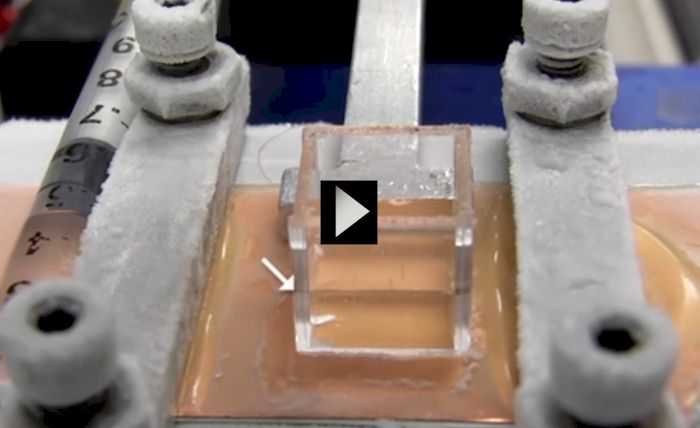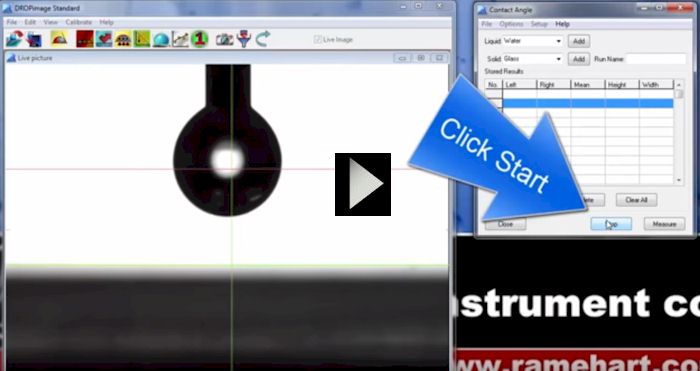|
|
|
|
April
2016 |
|
| Interfacial Cavitation | |
|
A lot of human capital has been expended
in recent years on figuring out how to make surfaces more hydrophobic or
even superhydrophobic. We've reported on
some of that progress in this monthly newsletter. However, a lot less
energy has gone into figuring out icephobicity - that is, how to make a
surface repel ice buildup.1 If you live in a region that has
winter weather with below freezing temperatures, think of the energy
spent scraping windshields, clearing sidewalks, and deicing airplanes
prior to takeoff. The term icephobic only started appearing in papers less than 10 years ago. There has been a temptation to correlate hydrophobicity with icephobicity since many hydrophobic surfaces are also icephobic. The temptation has been to assume that if a surface is hydrophobic, it will also be icephobic. But this conclusion does not always pan out and excludes other potentially better solutions. Researchers at the University of Michigan using a ramé-hart goniometer are developing a reliable and inexpensive coating technology that will repel ice.2 Their discovery is based on the premise that two solid surfaces, solid ice and a rigid surface, form a strong bond that requires a good deal of force to separate. However, if the rigid surface is made less rigid, it's a lot easier to separate it from ice. By making the surface rubbery, ice adhesion is greatly reduced because of a phenomenon called interfacial cavitation. When ice builds up on a rubbery surface, the ice wants to remain rigid while the surface wants to deform. At the interface a stress concentrator develops causing the ice to break free from the surface. Polyurethane and silicone, for example, are used to create these icephobic coatings and surfaces in the lab.
The icephobic properties of these new rubbery coatings are not a function of surface topology - which is the way we produce superhydrophobic surfaces - but rather a function of their physical properties. Optimized rubbery coatings developed at the University of Michigan exhibit not only some of the lowest ice adhesion strengths ever recorded, but these surfaces can be amazingly durable - able to withstand mechanical wear and real-world temperature swings and even hundreds of freeze/thaw cycles. Frozen food packing and commercial freezers applications could greatly benefit from this new icephobic coating technology. Eventually, automobile and aviation applications could also see innovative changes as a result of this novel discovery. If you find yourself studying icephobicity, consider a ramé-hart Contact Angle Goniometer coupled with our Peltier Environmental Chamber3 which is capable of controlled temperatures between -50°C and 150°C.
1
Our first discussion of icephobicity was in our March 2015 Newsletter
which can be found here:
http://www.ramehart.com/newsletters/2015-03_news.htm.
|
|
| DROPimage Standard Video - Measuring Contact Angle | |
|
The heart of DROPimage Standard (which is
included with Models 200 and 400) is measuring contact angle. Over the
years we've developed a number of tools, tutorials, even a Google knol
(now discontinued) to communicate to our customers the easy step-by-step
process of taking a contact angle measurement. However, in the past few
years, we've come to learn that videos are clearly the most helpful
method for doing so. Our new video (below) walks through the steps
involved in dispensing a volume of liquid onto a surface and then measuring
its contact angle. In this example, we are dispensing water onto a
glass surface and the measurements are taking using DROPimage Standard
Edition.
While the video above shows a contact angle measurement using DROPimage Standard, note that DROPimage CA (our more basic edition included with Model 190) as well as our more powerful DROPimage Advanced (included with Models 250 and higher) both include the same Contact Angle Tool. In the case of DROPimage Advanced, the Contact Angle Tool can be found on the pull-down menu CA Tools. With DROPimage CA, there is an icon on the toolbar. |
|
| April 2016 Coupon | |
If you've made it this far in our
newsletter, you deserve $20.
 So, please feel free to use the coupon above on your next purchase at our spare parts web store located at: www.ramehart.us. Limit one per customer. Expires at the end of April 2016. $50 minimum (subtotal before coupon) applies. |
|
|
|
Regards,
Carl Clegg |



